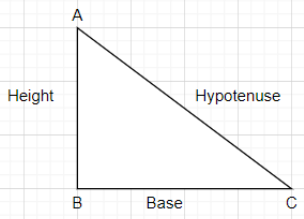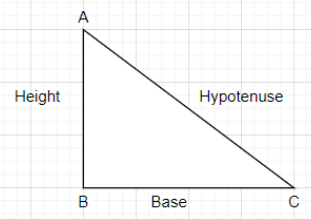Answer
412.8k+ views
Hint: In this question, we have multiple trigonometric functions. So we have to do trigonometric conversion multiple times. We have inverse tan function and inverse cot function. Assume, \[\theta ={{\cot }^{-1}}x\] and then transform \[\cot \theta \] into \[\sin \theta \] . Also assume \[\beta ={{\tan }^{-1}}\left( \dfrac{1}{\sqrt{1+{{x}^{2}}}} \right)\] and then transform \[\tan \beta \] into \[\cos \beta \] . Now, it can be solved easily.
Complete step-by-step solution -
Solve this question, step by step.
Treat \[\sin (co{{t}^{-1}}x)\] as the first part and then simplify this.
So, first of all, we have to solve \[\sin (co{{t}^{-1}}x)\].
Let us assume,
\[\theta ={{\cot }^{-1}}x\]
\[\Rightarrow \cot \theta =x\]…………..(1)
We have, \[\cot \theta =\dfrac{\text{base}}{\text{Height}} \],

Base = x,
Height= 1,
Using Pythagoras theorem Hypotenuse =\[\sqrt{{{\left(\text{height} \right)}^{2}}+{{\left(\text{Base} \right)}^{2}}}\], we get
Hypotenuse= \[\sqrt{1+{{x}^{2}}}\]
\[\sin \theta =\dfrac{\text{height}}{\text{hypotenuse}}\]
\[\sin \theta =\dfrac{1}{\sqrt{1+{{x}^{2}}}}\]
\[\Rightarrow \theta ={{\sin }^{-1}}\left( \dfrac{1}{\sqrt{1+{{x}^{2}}}} \right)\]………………(2)
According to the question, we have \[\cos [ta{{n}^{-1}}{\sin({\cot}^{-1}}x)\}]\]………….(3)
From equation(1), we have \[\theta ={{\cot }^{-1}}x\] .
Substituting equation(1) in equation(3), we get \[\cos [ta{{n}^{-1}}\{sin\theta \}]\]…………..(4)
Now, using equation(2), equation(4) can be written as
\[\begin{align}
& \sin ({{\sin }^{-1}}\left( \dfrac{1}{\sqrt{1+{{x}^{2}}}} \right)) \\
& =\dfrac{1}{\sqrt{1+{{x}^{2}}}} \\
\end{align}\]
Our equation may be written as,
\[\begin{align}
& \cos \left[ {{\tan }^{-1}}\left\{ \sin \left( {{\sin }^{-1}}\left( \dfrac{1}{\sqrt{1+{{x}^{2}}}} \right) \right) \right\} \right] \\
& =\cos \left[ {{\tan }^{-1}}\left( \dfrac{1}{\sqrt{1+{{x}^{2}}}} \right) \right] \\
\end{align}\]
We have simplified our equation given in the question.
Now, we have to solve the equation, \[\cos \left[ {{\tan }^{-1}}\left( \dfrac{1}{\sqrt{1+{{x}^{2}}}} \right) \right]\]……….(5)
For this, we have to convert the inverse tan function into inverse cosine function.
Similarly, let us assume,
\[\beta ={{\tan }^{-1}}\left( \dfrac{1}{\sqrt{1+{{x}^{2}}}} \right)\]……………..(6)
Solving equation(6), we get \[\tan \beta =\dfrac{1}{\sqrt{1+{{x}^{2}}}}\]…………..(7)
We also know the identity, \[{{\sec }^{2}}\beta -{{\tan }^{2}}\beta =1\] .
\[\sec \beta =\sqrt{1+{{\tan }^{2}}\beta }\]……………..(8)
Using equation(7) and substituting it in equation(8), we get
\[\begin{align}
& \sec \beta =\sqrt{1+{{\tan }^{2}}\beta } \\
& =\sqrt{1+\dfrac{1}{1+{{x}^{2}}}} \\
& =\sqrt{\dfrac{1+{{x}^{2}}+1}{1+{{x}^{2}}}} \\
& =\sqrt{\dfrac{2+{{x}^{2}}}{1+{{x}^{2}}}} \\
\end{align}\]
We also know that, \[\cos \beta =\dfrac{1}{\sec \beta }\] .
Using this formula we can find \[\cos \beta\] .
\[\cos \beta =\dfrac{\sqrt{1+{{x}^{2}}}}{\sqrt{2+{{x}^{2}}}}\]…………….(9)
Substituting equation(6) in equation(5), we get
\[\cos (ta{{n}^{-1}}\left( \dfrac{1}{\sqrt{1+{{x}^{2}}}} \right))\]
\[=\cos \beta \]
Substituting the value from equation(9), we get
\[\cos \beta =\sqrt{\dfrac{1+{{x}^{2}}}{2+{{x}^{2}}}}\]
Therefore,LHS=RHS
Hence, proved.
Note: In this question, we have to transform one trigonometric function into other trigonometric functions multiple times. So, one can easily make a mistake in the calculations involved in the transformation. It will be easier if we transform the functions using the right-angled triangle and Pythagoras theorem.

Pythagoras theorem,
Hypotenuse =\[\sqrt{{{\left( \text{height} \right)}^{2}}+{{\left(\text{Base}\right)}^{2}}}\] .
Using this formula, we can find height, base and hypotenuse. Now, transformation can be done easily.
Complete step-by-step solution -
Solve this question, step by step.
Treat \[\sin (co{{t}^{-1}}x)\] as the first part and then simplify this.
So, first of all, we have to solve \[\sin (co{{t}^{-1}}x)\].
Let us assume,
\[\theta ={{\cot }^{-1}}x\]
\[\Rightarrow \cot \theta =x\]…………..(1)
We have, \[\cot \theta =\dfrac{\text{base}}{\text{Height}} \],

Base = x,
Height= 1,
Using Pythagoras theorem Hypotenuse =\[\sqrt{{{\left(\text{height} \right)}^{2}}+{{\left(\text{Base} \right)}^{2}}}\], we get
Hypotenuse= \[\sqrt{1+{{x}^{2}}}\]
\[\sin \theta =\dfrac{\text{height}}{\text{hypotenuse}}\]
\[\sin \theta =\dfrac{1}{\sqrt{1+{{x}^{2}}}}\]
\[\Rightarrow \theta ={{\sin }^{-1}}\left( \dfrac{1}{\sqrt{1+{{x}^{2}}}} \right)\]………………(2)
According to the question, we have \[\cos [ta{{n}^{-1}}{\sin({\cot}^{-1}}x)\}]\]………….(3)
From equation(1), we have \[\theta ={{\cot }^{-1}}x\] .
Substituting equation(1) in equation(3), we get \[\cos [ta{{n}^{-1}}\{sin\theta \}]\]…………..(4)
Now, using equation(2), equation(4) can be written as
\[\begin{align}
& \sin ({{\sin }^{-1}}\left( \dfrac{1}{\sqrt{1+{{x}^{2}}}} \right)) \\
& =\dfrac{1}{\sqrt{1+{{x}^{2}}}} \\
\end{align}\]
Our equation may be written as,
\[\begin{align}
& \cos \left[ {{\tan }^{-1}}\left\{ \sin \left( {{\sin }^{-1}}\left( \dfrac{1}{\sqrt{1+{{x}^{2}}}} \right) \right) \right\} \right] \\
& =\cos \left[ {{\tan }^{-1}}\left( \dfrac{1}{\sqrt{1+{{x}^{2}}}} \right) \right] \\
\end{align}\]
We have simplified our equation given in the question.
Now, we have to solve the equation, \[\cos \left[ {{\tan }^{-1}}\left( \dfrac{1}{\sqrt{1+{{x}^{2}}}} \right) \right]\]……….(5)
For this, we have to convert the inverse tan function into inverse cosine function.
Similarly, let us assume,
\[\beta ={{\tan }^{-1}}\left( \dfrac{1}{\sqrt{1+{{x}^{2}}}} \right)\]……………..(6)
Solving equation(6), we get \[\tan \beta =\dfrac{1}{\sqrt{1+{{x}^{2}}}}\]…………..(7)
We also know the identity, \[{{\sec }^{2}}\beta -{{\tan }^{2}}\beta =1\] .
\[\sec \beta =\sqrt{1+{{\tan }^{2}}\beta }\]……………..(8)
Using equation(7) and substituting it in equation(8), we get
\[\begin{align}
& \sec \beta =\sqrt{1+{{\tan }^{2}}\beta } \\
& =\sqrt{1+\dfrac{1}{1+{{x}^{2}}}} \\
& =\sqrt{\dfrac{1+{{x}^{2}}+1}{1+{{x}^{2}}}} \\
& =\sqrt{\dfrac{2+{{x}^{2}}}{1+{{x}^{2}}}} \\
\end{align}\]
We also know that, \[\cos \beta =\dfrac{1}{\sec \beta }\] .
Using this formula we can find \[\cos \beta\] .
\[\cos \beta =\dfrac{\sqrt{1+{{x}^{2}}}}{\sqrt{2+{{x}^{2}}}}\]…………….(9)
Substituting equation(6) in equation(5), we get
\[\cos (ta{{n}^{-1}}\left( \dfrac{1}{\sqrt{1+{{x}^{2}}}} \right))\]
\[=\cos \beta \]
Substituting the value from equation(9), we get
\[\cos \beta =\sqrt{\dfrac{1+{{x}^{2}}}{2+{{x}^{2}}}}\]
Therefore,LHS=RHS
Hence, proved.
Note: In this question, we have to transform one trigonometric function into other trigonometric functions multiple times. So, one can easily make a mistake in the calculations involved in the transformation. It will be easier if we transform the functions using the right-angled triangle and Pythagoras theorem.

Pythagoras theorem,
Hypotenuse =\[\sqrt{{{\left( \text{height} \right)}^{2}}+{{\left(\text{Base}\right)}^{2}}}\] .
Using this formula, we can find height, base and hypotenuse. Now, transformation can be done easily.
Recently Updated Pages
Basicity of sulphurous acid and sulphuric acid are

Assertion The resistivity of a semiconductor increases class 13 physics CBSE

The Equation xxx + 2 is Satisfied when x is Equal to Class 10 Maths

What is the stopping potential when the metal with class 12 physics JEE_Main

The momentum of a photon is 2 times 10 16gm cmsec Its class 12 physics JEE_Main

Using the following information to help you answer class 12 chemistry CBSE

Trending doubts
Difference Between Plant Cell and Animal Cell

Difference between Prokaryotic cell and Eukaryotic class 11 biology CBSE

Fill the blanks with the suitable prepositions 1 The class 9 english CBSE

Change the following sentences into negative and interrogative class 10 english CBSE

Summary of the poem Where the Mind is Without Fear class 8 english CBSE

Give 10 examples for herbs , shrubs , climbers , creepers

Write an application to the principal requesting five class 10 english CBSE

What organs are located on the left side of your body class 11 biology CBSE

What is the z value for a 90 95 and 99 percent confidence class 11 maths CBSE



